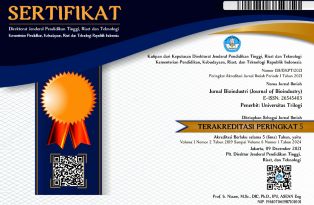APLIKASI BAKTERI PELARUT FOSFAT DAN ROCK PHOSPHATE TERHADAP KARAKTERISTIK FISIOLOGI TANAMAN TOMAT (Solanum lycopersicum L.)
Abstract
Phosphorus (P) is one of the essential nutrients that functions is metabolism in plant. Based on these functions, it indicates that nutrient P has an important role for plant growth and production. However, its availability in soil is very low, which is less than 0.01% of the total P. Therefore, the availability of P nutrients in the soil needs to be increased by increasing the activity of soil microorganisms through the use of phosphate solubilization bacteria. This research is aimed to show the changes in the physiological characteristics of tomato plants through the application of phosphate solubilization bacteria and rock phosphate. Experiment using factorial randomized block design (RBD) which consisted of 2 factors with 2 consultation levels on the first factor (phosphate solubilization bacteria) and 4 levels on the second factor (rock phosphate), and it consist of 8 combinationed of phosphate solubilization bacteria and rock phosphate with 3 replicated. The results showed that the combination treatment of phosphate solubilization bacteria and rock phosphate affected the physiological characteristics of tomato plants, especially on the variables of stomata density, leaf chlorophyll, plant height, plant dry weight, fruit weight and plant P-tissue content in the vegetative final phase. The recommendation of an efficient fertilizer combination to improve physiological characteristics and high yields is use the phosphate solubilization bacteria and rock phosphate 0.69 grams
Keywords: phosphate solubilization bacteria, physiological characteristic, rock phosphate
Keywords
Full Text:
PDFDOI: https://doi.org/10.31326/jbio.v2i1.178
DOI (PDF): https://doi.org/10.31326/jbio.v2i1.178.g286
Refbacks
- There are currently no refbacks.
Editorial Office:
Fakultas Bioindustri
Universitas Trilogi
Jl. TMP Kalibata No.1
Jakarta 12760
Copyright Notice:


2.png)






2.png)







